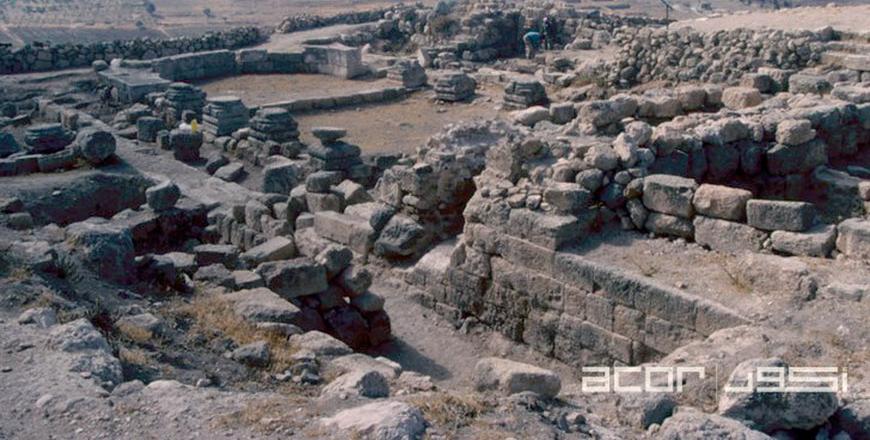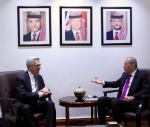You are here
Community archaeology challenges ‘colonial’ approaches to research — expert
By Saeb Rawashdeh - Jul 29,2017 - Last updated at Jul 29,2017

Oystein LaBianca
AMMAN — Community archaeology, a form of archaeology directed by experts to local communities, originated at Tell Hisban during the seventies and eighties, with anthropologists wanting to learn more about traditional Jordanian practices for securing food, water and protection for their households and animals, a Norwegian anthropologist said.
“The initial reason for this interest was as a way to learn more about how large quantities of animal bones became part of the daily bundle of loose finds dug up by archaeologists at the site,” Oystein LaBianca, a professor of anthropology at Andrews University in Michigan, US, told The Jordan Times in a recent e-mail interview.
The technical term for this kind of research is called “ethnoarchaeology”, the ethnographic study of people for archeological reasons, the scholar explained.
“As the amount of time and effort devoted to this new type of research increased, our awareness of the local community as an essential stakeholder in our expedition’s mission and success also began to expand,” LaBianca added.
“Gradually, our project was transformed from a traditional expeditionary mission to a community archaeology project,” the anthropologist stated, adding that, while colonial notions of scholarship predominated during the original Heshbon expedition [a previous project run in the Madaba plain] in the seventies, a new vision of community archaeology emerged during the past two decades under the banner of the Hisban Cultural Heritage Project.
“This new vision emphasises partnering with the local community in planning for the development, protection and presentation of archaeological sites in their backyards,” LaBianca noted.
According to the professor, the Hisban Cultural Heritage Project started in 1996 and its major goals have been to transform a “largely neglected and uninviting archaeological ruin” into an attractive archaeological park; to expand excavation and study of the early and mediaeval Islamic history of the site; to initiate research in the site’s extensive Ottoman remains; and to find ways to engage the local community in planning for development, protection and presentation of the site.
“We have made very good progress on all four fronts,” he stressed, commending cooperation with the local municipality, the residents of the site and the Department of Antiquities.
“Located at 885 metres above sea level, along the edge of the highland plateau that overlooks the Jordan River Valley from the east, the summit of Tell Hisban provides a panoramic view of the plains of Madaba, Mount Nebo and the northern tip of the Dead Sea,” LaBianca noted.
Due to its strategic location, its natural endowments in terms of annual rainfall amounts, fertile valleys and slopes, and construction-quality limestone, the site has seen almost continuous occupation since the Late Bronze Age, the archaeologist said.
Excavations at the site have uncovered traces of a long succession of imperial powers that have influenced the material culture and daily life at Hisban over the time, including the Assyrians, Neo-Babylonians, Ptolemaic Greeks, Romans, Byzantines, Umayyads, Abbasids, Ayyubids, Mamluks, Ottomans and British, he explained.
“Our research has also brought to light the daily lives and survival practices of their would-be subjects — the local farmers, craftsmen and merchants that have occupied the site throughout the millennia,” LaBianca noted.
“In fact, it is their story that is by far the best preserved in the discoveries from Tell Hisban. It was they who built and maintained the dozens of cisterns, terraces and other water-related installations that are found in abundance throughout the site,” he emphasised.
“Ordinary farmers carved and made their dwellings in the caves of the site, built houses and barnyard enclosures on its slopes, imported or made themselves the thousands of ceramic vessels and other household artifacts, populated the place with domestic animals, terraced the hillsides and planted them to olives and grapes,” LaBianca highlighted.
“The stories of these farmers are as important to share with visitors to the site as are those of their famous imperial overlords and kings,” La Bianca concluded.
Related Articles
TELL HISBAN — Over the years, the objectives of archaeological excavations at Tell Hisban, located in the Madaba Plain, have changed d
AMMAN — A mini-conference was organised on Wednesday at the German-Jordanian University and at a community centre in Hisban to mark the 50th
AMMAN — A recently published book titled “Hisban” offers insight into archaeological sites of the area of the Madaba plains and interactions


















